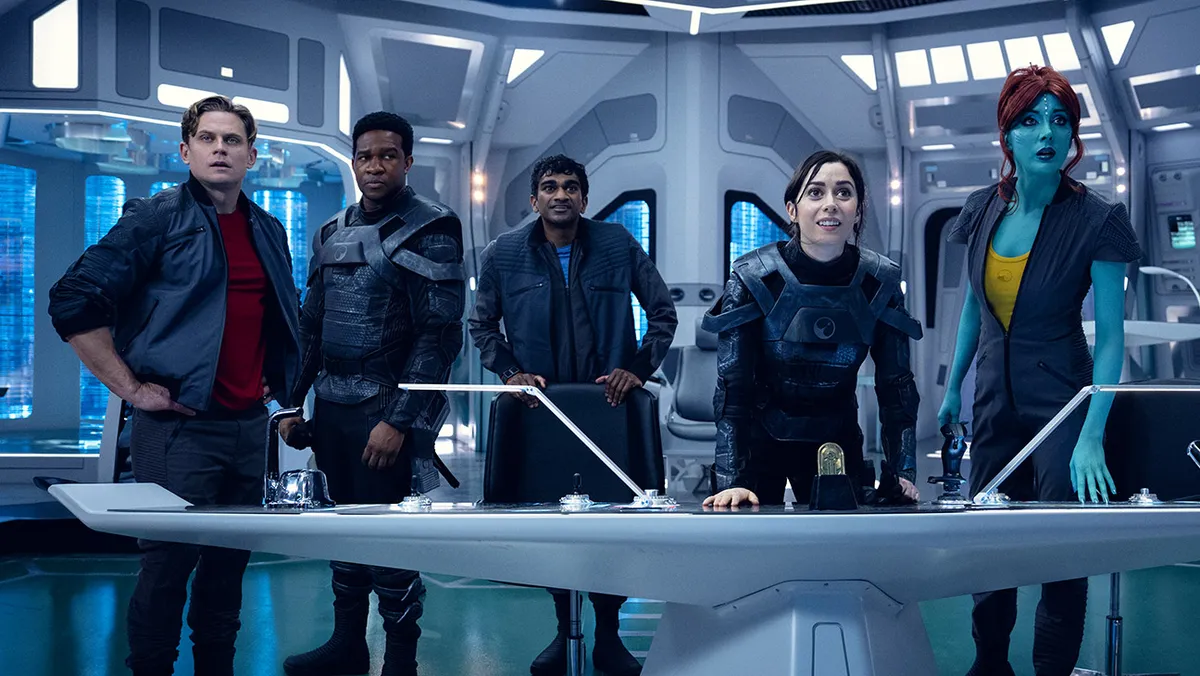
This article contains spoilers from the latest installment of Black Mirror season seven sequel, “USS Callister: Into Infinity.” The anticipation surrounding this sequel has been building since the first episode, “USS Callister,” debuted with the fourth season of Black Mirror in late 2017. Director Toby Haynes expressed to creator Charlie Brooker that they had crafted the best pilot for a space-themed series. Initially, Brooker was reluctant to discuss potential spinoffs for the acclaimed episode, which garnered four Emmys, but soon the future of “Callister” began to shine brightly.
Haynes shared insights with The Hollywood Reporter about the lengthy process of bringing “Callister” back to Netflix. He revealed that discussions about a potential series started back when he was working on Andor. However, the Hollywood strikes of 2023 disrupted production plans. In a creative turn, Brooker and executive producer Jessica Rhoades reimagined the project as a 90-minute feature film, marking Black Mirror’s first-ever sequel, “USS Callister: Into Infinity.” This sequel is now streaming alongside the rest of season seven.
Haynes described the challenge of creating a follow-up to the Emmy Award-winning film, stating, “We were all kind of haunted by the people we were seven years ago who made this.” He emphasized that the sequel aims to be “bigger, better, more exciting, funnier, and more emotional.” He likened this installment to iconic sequels such as Empire Strikes Back, Aliens, or Terminator 2. Haynes expressed enthusiasm about elevating the narrative to a full-fledged movie series, declaring, “Great sci-fi belongs in that space.”
Reflecting on the evolution of “Callister,” Haynes noted that discussions about a series format were serious and comprehensive. Initially conceived as a miniseries, the project faced hurdles due to the strikes, which eventually led to its transformation into a standalone film. He praised Rhoades for her role in accelerating the project, making it clear that the shift to a single film format allowed for a more focused and high-quality narrative.
Haynes elaborated, “The transition from series to sequel didn’t lose any of the story’s essence.” He credited Brooker’s high standards for storytelling and emphasized that every element in the film is of the highest quality. “There’s never a dull joke or a superfluous piece of information,” he stated, underscoring the meticulous nature of Brooker’s writing.
The reunion of the original cast, including Cristin Milioti and Jesse Plemons, was a significant highlight for Haynes. He noted that Milioti’s performance was remarkable as she returned to her character, now the captain of the USS Callister. The chemistry among the cast was palpable, and the team was able to capture the essence of their characters while reflecting on the passage of time since the original episode aired.
One of the film's intriguing aspects is the return of Plemons’ character, Robert Daly, who had died in the first episode. This unexpected twist was kept under wraps to maintain an element of surprise for the audience. Haynes explained, “We had to show a different side to Robert Daly,” which required careful character development to ensure a fresh narrative while still retaining the tension from the original story.
The production of “USS Callister: Into Infinity” faced numerous challenges, including the need to recreate sets from the original episode. Haynes praised production designer Miranda Jones, who worked closely with the original team to bring the sets back to life. The collaboration extended to the visual effects and props, with a focus on creating a distinct aesthetic that melded elements of sci-fi and gaming culture.
With a larger budget this time around, the film was able to explore more elaborate visual effects and set designs, making it a significant upgrade from the first installment. Haynes remarked, “It’s an upgrade, isn’t it? ‘Callister’ upgraded!”
Thematically, “USS Callister: Into Infinity” continues to explore complex issues, much like its predecessor, which touched on themes related to the MeToo movement. Haynes noted the importance of delivering a satisfying conclusion, balancing the bittersweet elements that characterize Black Mirror. He and Brooker discussed the ending extensively to ensure it resonated with the audience while maintaining the show’s signature tone.
In the sequel, characters escape their dire circumstances but find themselves in a new dilemma, which Haynes describes as a “hell” of its own. The film’s conclusion leaves room for further exploration, should the opportunity arise for additional sequels.
As for the potential of future installments in the Callister saga, Haynes expressed hope that the stars would align for another film. He noted the collaborative spirit and dedication of the entire team, revealing, “If the planets align, we’ve got a fantastic premise to begin on.” Whether or not another film materializes, the journey of “USS Callister: Into Infinity” illustrates the evolution of storytelling within the Black Mirror universe.
In conclusion, “USS Callister: Into Infinity” not only serves as a thrilling sequel but also as a testament to the creative potential of Black Mirror. With its blend of humor, emotional depth, and engaging narrative, the film stands as a worthy continuation of the beloved original. Fans of the series can look forward to the possibility of more adventures in the future.